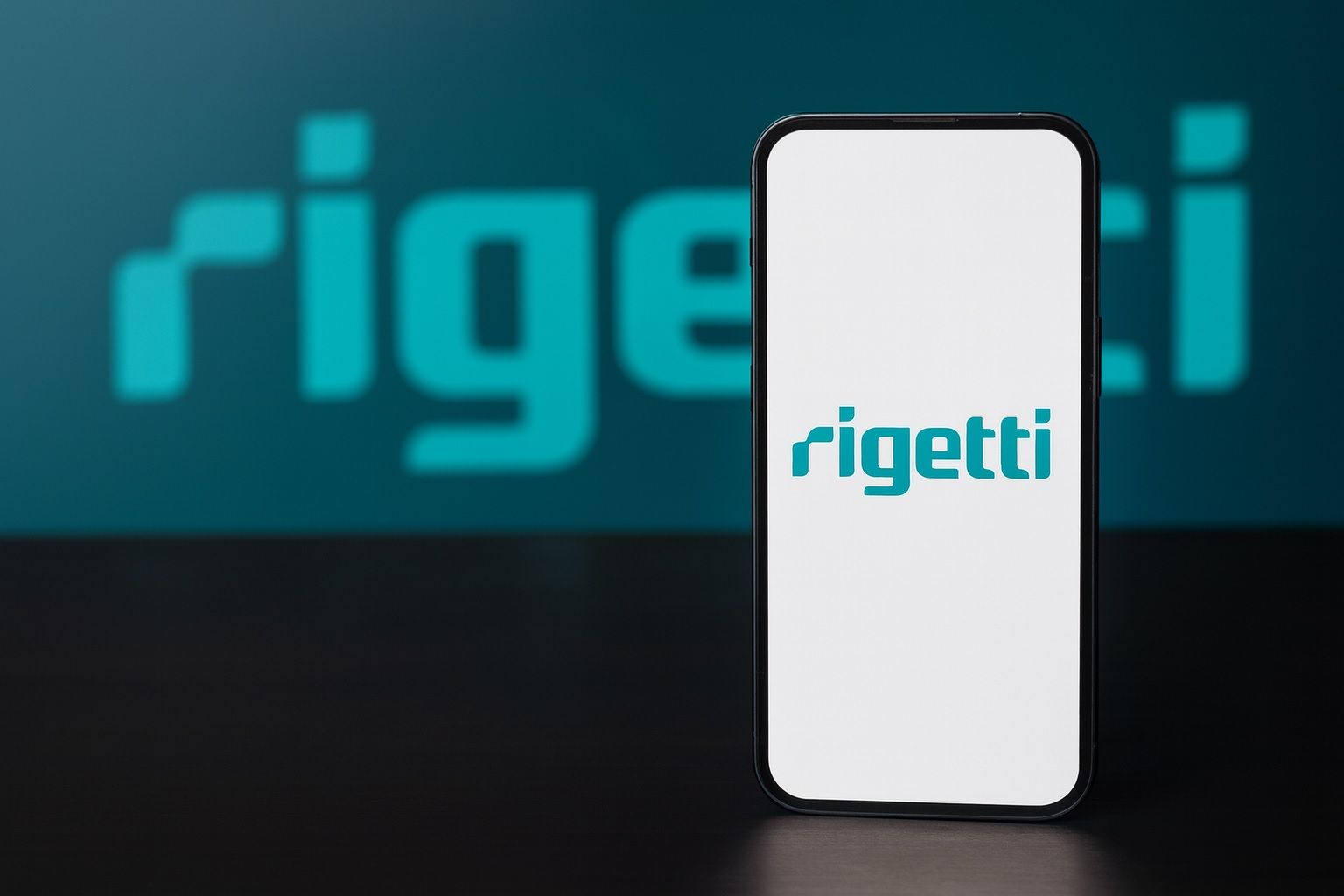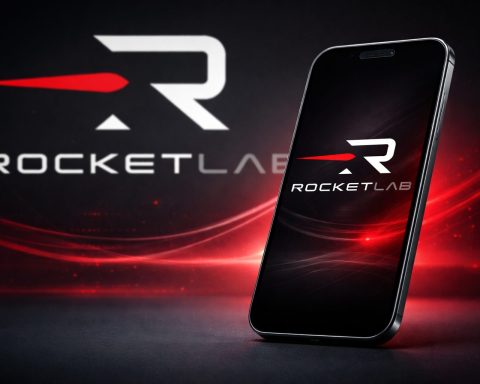- Record Surge: Rigetti Computing (NASDAQ: RGTI) stock hit an all-time high of around $56 per share last week after spiking 25% in a single day on Oct. 13 [1]. Shares have skyrocketed over 5,000% in the past year, transforming the once-penny stock into a multi-billion dollar high-flyer [2]. As of Oct. 20, RGTI trades around the mid-$40s (≈$47–48), reflecting a slight pullback from its peak but still an astronomical gain year-over-year.
- Volatile Pullback: After reaching its record high mid-week, Rigetti’s stock plunged nearly 15% on Thursday, Oct. 16, and dipped further on Friday [3]. It settled in the mid-$40s by week’s end amid broader market jitters and profit-taking [4]. Even after this slide, RGTI remains up exponentially – its 52-week range spans roughly $0.80 to $58 [5] – highlighting extreme volatility.
- Deals Fueling Hype: Recent contract wins and tech breakthroughs have underpinned investor excitement. In late September, Rigetti secured a $5.8 million U.S. Air Force contract (with partner QphoX) to develop quantum networks, and announced $5.7 million in new orders for its Novera quantum computers [6]. The company also launched a 36-qubit quantum processor available via the cloud – concrete milestones that have helped drive the stock’s rapid ascent [7].
- Sky-High Valuation vs. Tiny Sales: Despite a market capitalization near $17 billion, Rigetti’s annual revenue is only on the order of $8–10 million, and the company remains deeply unprofitable [8]. RGTI now trades at an eye-popping 1,500×+ its sales – an almost unprecedented multiple [9]. This huge disconnect between valuation and fundamentals is raising bubble concerns on Wall Street.
- Analysts Bullish but Cautious: Every Wall Street analyst covering Rigetti reportedly rates it a “Buy,” reflecting optimism about its long-term potential. However, their average 12-month price targets in the $20s are roughly 50% below Rigetti’s recent trading levels [10]. Analysts praise Rigetti’s technology but warn the quantum computing stock boom may be unsustainable, predicting a possible pullback as reality catches up to hype [11].
Stock Rockets to Record High, Then Whipsaws
Figure: RGTI share price from late September through mid-October 2025, showing a meteoric rise into the $50s followed by a sharp pullback to the $40s.
Rigetti’s stock price has been on a breathtaking tear in 2025, riding an investor frenzy around quantum computing. At the start of the year, RGTI traded below $1 per share; by mid-October it had rocketed into the mid-$50s [12]. The stock closed at a record $56.34 on October 15, 2025 [13] – roughly a 50-fold increase from a year ago. In the span of a single week, Rigetti shares surged from the mid-$40s to new highs, including a 25% leap on Oct. 13 alone (closing around $54.91) [14]. This frenetic rally catapulted Rigetti’s market value into the $16–18 billion range [15] – an astounding figure given the company’s minimal revenues.
The exuberance isn’t isolated to Rigetti. Other pure-play quantum computing stocks have skyrocketed this year amid a speculative “quantum boom.” IonQ, for example, is up roughly 700% year-over-year, while D-Wave has surged over 2,000% [16]. Investors have been piling into the sector’s promise, driving many of these formerly obscure names to stratospheric heights.
However, Rigetti’s quantum-fueled rocket hit turbulence late last week. On Thursday, Oct. 16, RGTI abruptly plunged ~15% intraday, falling from the $50s down into the high-$40s [17] [18]. The sell-off continued into Friday’s pre-market, with Rigetti sliding another ~7–8% at one point before stabilizing around the mid-$40s [19] [20]. All of the “Quantum Four” stocks (Rigetti, IonQ, Quantum Computing Inc., and D-Wave) saw double-digit drops that day [21] [22]. Even after retracing from its peak, Rigetti remains up roughly 5,000% from a year ago [23] – a stunning gain that underscores both the thrill and the risk of this run. The stock’s 52-week trading range now stretches from well under $1 to about $58 [24], encapsulating its wild boom-bust swings.
Notably, there was no negative news from Rigetti itself to spark the sudden tumble. Instead, the slide came amid broader market turmoil and likely some prudent profit-taking. On Oct. 16, a scare in the banking sector (a regional bank disclosed a major fraud loss) spooked the overall market [25]. High-flying tech names – especially speculative darlings like Rigetti – were hit hard as traders rushed to lock in gains. Observers noted that after such a parabolic rise, it was almost inevitable some investors would “gravitate toward safe-haven” assets or take money off the table at the first hint of trouble [26]. In Rigetti’s case, reports also surfaced that CEO Subodh Kulkarni had quietly sold 1,000,000 shares (his entire personal stake) earlier in the year [27] [28]. News of this insider selling – combined with technical signals that Rigetti’s stock was severely overbought – gave traders another reason to hit the brakes after the stock’s euphoric climb [29] [30]. In short, after an unbelievable run-up, RGTI got a reality check: even quantum rockets don’t go up in a straight line forever.
Big Deals, Partnerships & Tech Breakthroughs
Rigetti’s recent fundamental developments help explain why its stock caught fire in the first place. Over the past few weeks, the company has unveiled a string of contracts, partnerships and R&D milestones that lend credibility to its long-term prospects – and have stoked investor optimism that Rigetti can turn quantum hype into reality.
Military & Government Contracts: In late September, Rigetti (in partnership with Dutch startup QphoX) won a $5.8 million contract from the U.S. Air Force to develop quantum networking technology [31]. The Air Force deal, part of an Air Force Research Lab program, validates Rigetti’s technical capabilities in a defense context and positions the company as a player in future military applications of quantum computing. Around the same time, Rigetti also announced it had secured $5.7 million in purchase orders for two of its new “Novera” quantum computers [32]. These orders – reportedly from an Asia-based manufacturer and a U.S. AI startup – represent the company’s first significant commercial hardware sales, slated for delivery in 2026 [33]. For a firm that booked only about $1.8 million in revenue last quarter [34], landing over $5 million in new orders is a notable step forward.
Technology Milestones: On the innovation front, Rigetti recently launched a 36-qubit quantum processor available to clients via its cloud platform [35]. This new chip (an upgrade in qubit count and performance) expands Rigetti’s Quantum Cloud Services offering and demonstrates progress in increasing the scale of its quantum computers. The company is pursuing a full-stack approach – designing and fabricating its own superconducting quantum chips, while also developing the software (like its Quil programming language and QCS cloud service) to use them [36]. Such vertical integration could be a long-term strength if Rigetti’s technology proves viable. These tangible achievements – from contracts to product rollouts – have helped fuel the narrative that Rigetti is not just hype, but is making real strides in the race to build useful quantum machines.
Broader Partnerships: Rigetti has also benefited from the halo effect of broader industry moves. Just ahead of the recent rally, banking giant JPMorgan Chase announced a sweeping $10 billion technology initiative that explicitly highlighted quantum computing as a key investment area [37]. That signal of institutional interest in quantum tech ignited sector-wide enthusiasm, with Rigetti leading the pack. Additionally, public interest in quantum computing spiked after the 2025 Nobel Prize in Physics recognized pioneering work in quantum information science – adding to the sense that the field’s moment has arrived [38]. In short, Rigetti has been riding a perfect storm of company-specific news and industry buzz: each new contract or partnership reinforces the excitement, and each headline about quantum breakthroughs or big funding plans sends more investors scrambling to grab a piece of the “next big thing.”
Analysts See Promise – and Risks
Despite the stock’s rollercoaster ride, professional analysts remain constructively optimistic about Rigetti’s long-term potential in quantum computing – but many are waving caution flags about the current valuation. According to TS2 and other reports, every Wall Street analyst covering RGTI rates it a Buy [39]. This unanimous bullishness reflects the belief that Rigetti could eventually capitalize on a huge market opportunity if quantum computing comes of age. The company’s comprehensive strategy – from building its own quantum processing units to offering cloud access – positions it as one of the leading pure plays in the space. “Rigetti takes a comprehensive approach… designing and building its own [quantum] chips… and creating a programming language,” noted The Motley Fool, highlighting the startup’s end-to-end vision [40].
That said, even bullish analysts acknowledge the disconnect between hype and reality. Most have 12-month price targets in the mid-$20s [41] – roughly half the latest trading price, implying they did not foresee the stock zooming this high this fast. In other words, Wall Street’s base case is that RGTI may have run far ahead of its fundamentals. “The quantum computing stock boom may be unsustainable,” one analysis warned, predicting a sharp pullback as reality catches up with hype [42].
Reality Check on Fundamentals: Indeed, Rigetti’s financials underscore why some experts urge caution. The company is deep in the red – in Q2 alone it lost $19.8 million on only $1.8 million of revenue [43] – and it’s still years away from any possibility of profits. To fund its R&D, Rigetti has had to dilute shareholders: it raised $350 million in June via a massive stock offering that increased the share count by 74% [44]. That cash bolsters the balance sheet for now, but won’t last forever given the heavy cash burn. “With viable quantum computers potentially over a decade away, management will likely need to substantially dilute current shareholders” to keep the company going, The Motley Fool observed bluntly [45]. McKinsey & Co. analysts likewise predict that truly scalable quantum devices may not be commercially viable until ~2040 [46] – meaning companies like Rigetti could face many lean years of further development before the technology pays off. This long timeline is a key risk for investors. In fact, one Motley Fool commentator argued that for Rigetti, “if anything, it’s too early” to buy now – advising would-be investors to wait for a major correction or clear technological breakthrough before jumping in [47].
Quantum Computing Boom Spurs Hype and Skepticism
Rigetti’s saga is unfolding against the backdrop of a broader quantum computing boom – one that has captivated markets, but also drawn comparisons to past tech hype cycles. The allure is obvious: quantum computers promise to solve problems far beyond the reach of classical supercomputers, potentially revolutionizing fields from drug discovery to cryptography. Recent breakthroughs have added fuel to the fire. For instance, late last year Google unveiled a state-of-the-art quantum chip (“Willow”) that dramatically improved error correction – reportedly solving a benchmark problem in about 5 minutes that would take a classical supercomputer 10^28 years (ten septillion years) to crack [48]. Such milestones feed the narrative that a quantum revolution is on the horizon. Quantum technology could even amplify the AI boom, by speeding up tasks like machine learning model training and optimization [49]. It’s no wonder investors are treating quantum computing as the next frontier with enormous payoff potential.
Yet the extreme valuations and frenzied trading in tiny quantum stocks like Rigetti have raised eyebrows. On online forums and social media, some retail investors voice deep skepticism about the pure-play quantum firms. “Quantum is totally overhyped and overbought,” one user vented on Reddit amid Rigetti’s recent run-up [50]. Another remarked, “All pure quantum is a scam. The only [company] which is actually trustworthy is IBM. And maybe Alphabet.” [51] – pointing out that tech giants like IBM and Google (which have substantial quantum research programs) might be safer bets than speculative startups. The fact that Rigetti’s CEO cashed out his entire stake earlier in the year only amplifies the skepticism for some observers. “Rigetti’s CEO is one of the few honest people in quantum… He openly stated that revenues are not coming anytime soon and that the company is overvalued. Of course he is selling shares,” one commenter noted, suggesting even management knows the stock’s price has outpaced reality [52]. This unusually zero-skin-in-the-game stance from leadership (Kulkarni now holds no RGTI shares after his May sell-off) has not gone unnoticed [53] [54]. In a sector prone to hype and unproven promises, a CEO with no personal stake is a red flag to some – though others interpret it simply as prudent honesty about the long road ahead.
Outlook: High Hopes vs. Hard Reality
Rigetti’s incredible rise and recent volatility encapsulate the dual nature of the quantum computing boom: tantalizing promise and rampant speculation in equal measure. The company has made commendable progress – signing up real customers, advancing its technology, and drawing support from government and industry partners – all of which suggest it could be a long-term winner in quantum computing if the field matures as hoped. This optimism is reflected in bullish analyst coverage and the continued enthusiasm of many investors who see Rigetti as a potential “ground floor” opportunity in a transformative technology.
At the same time, the stock’s violent swings and heady valuation are reminders of just how ahead of fundamentals the market has leapt. Rigetti is still essentially a research-stage company with modest revenue and big ongoing losses. It operates in an industry that, by most expert accounts, will require many years of grinding R&D before quantum computers deliver widespread commercial value. In the near term, that means Rigetti’s stock could remain extremely volatile, driven more by news, momentum and sentiment than by financial metrics.
For now, all eyes are on Rigetti’s next moves. Any new contract wins, technology breakthroughs, or partnerships (perhaps in hot areas like AI) could extend the rally and reinforce believers’ faith. Conversely, any stumble in execution – or simply a shift in market mood away from speculative tech – could bring the gravity defying stock back down to earth. After a 5,000% blast-off, even the CEO urges caution about the journey ahead. Rigetti’s quantum dream is very much alive, but investors are learning in real time that even in the future of computing, there’s no shortcut around the laws of economic gravity.
Sources: Rigetti stock and market data [55] [56]; ts2.tech news analyses [57] [58]; Fast Company [59] [60]; The Motley Fool [61] [62]; Benzinga/Reddit [63] [64].
References
1. ts2.tech, 2. ts2.tech, 3. ts2.tech, 4. ts2.tech, 5. ts2.tech, 6. ts2.tech, 7. ts2.tech, 8. ts2.tech, 9. ts2.tech, 10. ts2.tech, 11. ts2.tech, 12. ts2.tech, 13. ts2.tech, 14. stockanalysis.com, 15. ts2.tech, 16. ts2.tech, 17. www.fastcompany.com, 18. www.fastcompany.com, 19. www.fastcompany.com, 20. www.fastcompany.com, 21. www.fastcompany.com, 22. www.fastcompany.com, 23. www.fastcompany.com, 24. ts2.tech, 25. www.fastcompany.com, 26. www.fastcompany.com, 27. ts2.tech, 28. www.benzinga.com, 29. ts2.tech, 30. www.benzinga.com, 31. ts2.tech, 32. ts2.tech, 33. finviz.com, 34. finviz.com, 35. ts2.tech, 36. finviz.com, 37. ts2.tech, 38. ts2.tech, 39. ts2.tech, 40. finviz.com, 41. ts2.tech, 42. ts2.tech, 43. finviz.com, 44. finviz.com, 45. finviz.com, 46. finviz.com, 47. finviz.com, 48. finviz.com, 49. finviz.com, 50. www.benzinga.com, 51. www.benzinga.com, 52. www.benzinga.com, 53. www.benzinga.com, 54. www.benzinga.com, 55. stockanalysis.com, 56. stockanalysis.com, 57. ts2.tech, 58. ts2.tech, 59. www.fastcompany.com, 60. www.fastcompany.com, 61. finviz.com, 62. finviz.com, 63. www.benzinga.com, 64. www.benzinga.com







